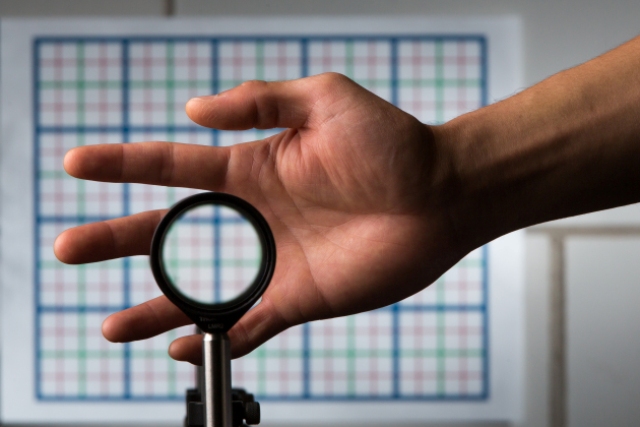 A multidirectional `perfect paraxial’ cloak using four lenses. From a continuous range of viewing angles, the hand remains cloaked, and the grids seen through the device match the background on the wall (about 2 m away), in color, spacing, shifts, and magnification. // photo by J. Adam Fenster / University of Rochester
A multidirectional `perfect paraxial’ cloak using four lenses. From a continuous range of viewing angles, the hand remains cloaked, and the grids seen through the device match the background on the wall (about 2 m away), in color, spacing, shifts, and magnification. // photo by J. Adam Fenster / University of Rochester
University of Rochester researchers have developed an invisibility cloak by combining four ordinary lenses which can hide objects across a range of angles.
This cloak, known as the Rochester cloak, is capable of 3D continuous multi-directional cloaking which enables the transmission of rays in the visible spectrum. The standard principle behind a cloaking device is to manipulate light in such a way that it conceals the object by using high-tech materials.
John Howell, a Physics professor from the University of Rochester, and Joseph Choi, a PhD student at the University’s Institute of Optics, carried out the research study. The research team calculated the optical power required and the distance to separate the lenses in order to cloak both the object and keep the background untouched. The device was tested by keeping the cloaked object facing a grid background.
This is the first device that we know of that can do three-dimensional, continuously multidirectional cloaking, which works for transmitting rays in the visible spectrum.
Joseph Choi, a PhD student at Rochester’s Institute of Optics
The researchers made observations through the lenses and altered the viewing angle appropriately. A corresponding shift in the grid was found as if there was no cloaking device. The grid lines at the rear of the cloaked object were continuous when compared to the background and there was a matching of the grid size magnification.
It is possible to scale up the Rochester Cloak to the size of a lens, enabling fairly large objects to be cloaked. However the device has its limitations.
The Rochester Cloak
Light is bent and transmitted through the device’s centre and hence it is not possible to conceal the on-axis region resulting in a doughnut-shaped cloaked region. Choi stated that they are working on more complex designs in order to overcome this problem. The cloak also has edge effects but these can be minimised by making use of large lenses.
This device could allow surgeons to look through their hands in order to see what they are operating on or for drivers to be able to view the blind spots on their vehicles.